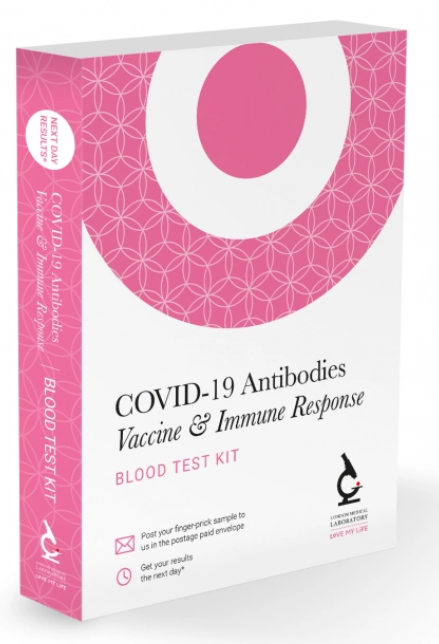The home test uses a finger-prick blood sample you can take yourself in the comfort of your own home. Or you can choose to have a blood sample taken in-store.
Whether you have been recently vaccinated or caught Covid-19 naturally, this IgG test will confirm whether your immune system has developed neutralizing IgG antibodies and give you a quantitative measure of your body’s response (between levels of 0 – 80,000 AU/ml).
It will help you to know how your immune system has responded to vaccination or infection to confirm whether the illness you had was Covid-19 or something else.
IgG levels often reduce quite quickly in the months after infection and this test will enable you to monitor your IgG levels over time to see if your levels are dropping below the levels that may be assumed to give immunity.
You can complete your Coronavirus IgG Antibody Home Test in three ways:
- At-home – Have the finger-prick testing kit delivered to you where you can take your blood sample, register your test and return it to our lab via a supplied Royal Mail 1st Class envelope.
- In-store – Book an appointment to have your blood sample taken by our trained team at your nearest London Medical Laboratory site (an additional £30 phlebotomy fee applies).
- Home Visit Phlebotomy – We organize a certified phlebotomist to take your blood from your home or office if you live within the M25 (an additional £80 phlebotomy fee applies).
Once your sample has been processed, you will receive your results via email. Please don’t forget to register your test before sending it back to us (a link will be provided after purchase).
o get tested, order your IgG Quantitative Immune Response Test today.
How is this test different from the older antibody tests and what will it tell me?
The older IgG and IgM antibody tests checked if you had antibodies in your system from being infected with Covid-19 in the past.
With this new quantitative test – produced by the world’s leading laboratory diagnostics provider – you will know if you have had Covid-19; and if your vaccination has worked. You will also get an accurate measure of how much your immune system has responded. This is a great improvement and gives you much more useful information than was previously available to us.
Your sample will be analyzed for the actual level of IgG antibodies in your body. If you receive a positive result, this is because the test detected an AU/ml level of above 50 units, which can be taken to confirm that you have been either exposed to coronavirus or that your body has produced an immune response to your vaccination.
This latest IgG test also measures a different viral protein than the previous one (from May 2020). The old IgG test would not measure whether your body has responded to the different vaccines whereas this new test does. This quantitative IgG test measures your levels of IgG antibodies against the spike receptor-binding domain (RBD) of SARS-CoV-2 whereas the previous test measured IgG against nucleoprotein. The spike protein is the main protein that is associated with the body mounting an immune response. It is also the protein that all the immunizations are mimicking to get the body’s immune system to fight off the virus so this test will tell you how well your body has responded to the vaccine.
Please note, that it is not yet clear how your immune response relates to whether you are immune or not. Research into this is ongoing so do not presume you are immune – even with a positive result. This virus has not been around for long enough for the scientists to be sure at what levels of IgG antibodies make you immune, even at high levels.
When should I take this test?
This test is best taken at least seven days after your initial coronavirus infection or vaccination. Your levels are likely to continue to rise up to 15 days when it is 99.4% sensitive in confirming your exposure to the spike protein of the virus.
How do I take a finger-prick blood sample myself?
Your test kit contains easy-to-follow instructions on how to take your own finger blood sample.
Home testing kit contents
Your testing kit will include:
- An introduction letter with instructions
- A blood collection tube
- Multiple lancets
- A test request form
- A blood tube holder
- A biohazard plastic bag
- A prepaid tracked return envelope



